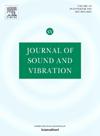Synthetically-trained neural networks for shape classification from measured acoustic scattering
IF 4.3
2区 工程技术
Q1 ACOUSTICS
引用次数: 0
Abstract
Drawing inspiration from the biological phenomenon of echolocation, ultrasound perception holds immense potential across various engineering domains, spanning from advanced imaging to precise navigation. Despite advances in sensor development and signal processing, current methodologies struggle to match the remarkable perceptual acuity of echolocating animals when deciphering real-world ultrasound echoes. In this study, we bridge this disparity by harnessing Convolutional Neural Networks (CNNs) to discern ultrasound scattering from objects of different shapes. Our novel approach entails training CNNs using exclusively synthetic data, derived from numerical simulations, to process real echoes. We achieve this through (1) sophisticated data augmentation and processing of synthetic echoes that accommodate physical variations and uncertainties inherent in practical scenarios and (2) specialized CNNs (SCNNs) targeted at each shape to compel models to learn features unique to that shape. Rigorous experimentation demonstrates the ability of these synthetically-trained models to accurately classify fundamental geometric shapes of objects based solely on experimentally measured echoes. Furthermore, the intentional selection of the size and shapes of the objects to produce perceptually similar echoes elucidates the efficacy of our approach in handling intricate perception scenarios. By alleviating laborious and costly data acquisition procedures in favor of synthetic data-driven training for real-world perception, our method opens avenues for advancements in diverse fields reliant on ultrasound-based technologies. These advancements bear implications spanning from diagnostics to the realm of autonomous systems and beyond.

基于测量声散射的形状分类的综合训练神经网络
从回声定位的生物现象中汲取灵感,超声波感知在从高级成像到精确导航的各个工程领域具有巨大的潜力。尽管在传感器发展和信号处理方面取得了进步,但目前的方法在破译真实世界的超声波回声时,仍难以与回声定位动物的显著感知灵敏度相匹配。在这项研究中,我们利用卷积神经网络(cnn)来识别不同形状物体的超声波散射,从而弥合了这种差异。我们的新方法需要使用来自数值模拟的合成数据来训练cnn,以处理真实的回声。我们通过(1)复杂的数据增强和处理合成回波,以适应实际场景中固有的物理变化和不确定性;(2)针对每种形状的专用cnn (scnn),迫使模型学习该形状的独特特征。严格的实验证明,这些综合训练的模型能够仅根据实验测量的回波准确分类物体的基本几何形状。此外,有意选择物体的大小和形状以产生感知上相似的回声,说明了我们的方法在处理复杂的感知场景时的有效性。通过减轻费力和昂贵的数据采集过程,支持合成数据驱动的现实世界感知训练,我们的方法为依赖超声技术的不同领域的进步开辟了道路。这些进步的意义涵盖了从诊断到自主系统乃至更远的领域。
本文章由计算机程序翻译,如有差异,请以英文原文为准。
求助全文
约1分钟内获得全文
求助全文
来源期刊

Journal of Sound and Vibration
工程技术-工程:机械
CiteScore
9.10
自引率
10.60%
发文量
551
审稿时长
69 days
期刊介绍:
The Journal of Sound and Vibration (JSV) is an independent journal devoted to the prompt publication of original papers, both theoretical and experimental, that provide new information on any aspect of sound or vibration. There is an emphasis on fundamental work that has potential for practical application.
JSV was founded and operates on the premise that the subject of sound and vibration requires a journal that publishes papers of a high technical standard across the various subdisciplines, thus facilitating awareness of techniques and discoveries in one area that may be applicable in others.
 求助内容:
求助内容: 应助结果提醒方式:
应助结果提醒方式:


